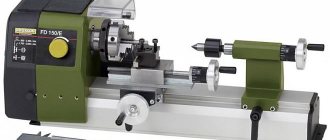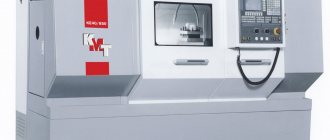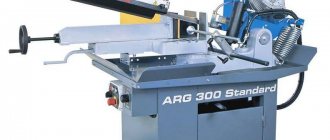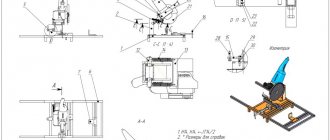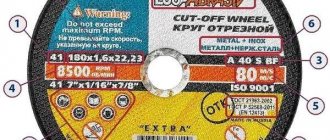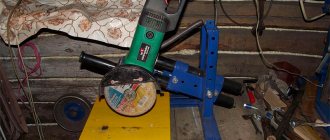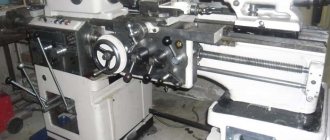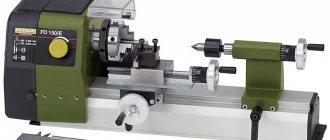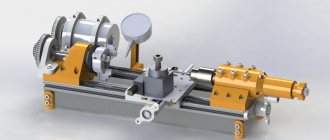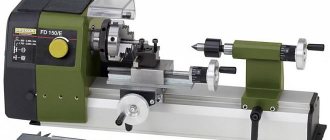SHARE ON SOCIAL NETWORKS
FacebookTwitterOkGoogle+PinterestVk
From this article you can learn the features of such a tool as a disc cutting machine for metal: types of designs, advantages and disadvantages, technical characteristics. Here you can get acquainted with the products of the most popular and sought-after manufacturers. The article examines in detail the technical and operational features of machines designed for cutting metal, and also provides a comparative description of market prices.
Disc devices for cutting metal have many configurations and can be used both in industry and in a small home workshop
Disc cutting machine for metal: scope of application
A cutting machine designed for working with metal is an electric tool with a high level of performance. This type of equipment is used for cross cutting of rolled metal blanks, as well as products made from metals and various alloys.
Disc machines are used to form workpieces from materials such as:
- corner;
- metal strip;
- rod;
- I-beam;
Disk equipment is considered the most popular among metal cutting devices
- profile pipe having a round or square cross-section;
- channel;
- other rolled metal elements.
Note! Disk equipment is considered the most popular. Band saws and hacksaw machines are also used for cutting metal, but they are less popular.
Disk equipment is used at metalworking industry facilities, as well as at factories involved in the manufacture of metal structures. A circular saw is used as a cutting element.
Machine designs have many advantages:
- simple structure;
- high-quality metal cutting;
- ergonomic control;
- ease of operation.
The equipment can be operated by an operator who does not have special qualifications.
Automatic Disc Cutting Machine
Band-cutting machines for metal use a long toothed saw as a cutting element, which has the appearance of a closed band. The material for the manufacture of this part is high-speed steel. Thanks to the minimum cutting width, material loss is reduced and an accurate cut is obtained. This type of equipment is most often used in large and serial production.
A hacksaw blade is used to cut metal workpieces in hacksaw units. It is mounted on the saw frame. Such machines can have a manual or electromechanical operating principle. Hacksaw machines are used in small enterprises and in procurement shops.
The device of a disc cutting machine for metal
The equipment is assembled on a platform. This structure can have a metal or rigid base. Moreover, the placement of the machine components is not stationary, but removable. The tool is equipped with a vice with a reliable stop, thanks to which workpieces with different types of configuration are firmly held during the cutting process.
For cutting metal, a disk made of high-speed or carbide steel is used. Instead, a circle made of material with an abrasive hard surface can be used.
The rotational motion is transmitted to the cutting element from the electric motor through a gear or belt drive. The first option is installed on stationary equipment with a high power reserve, the second is suitable for compact tools with a portable design.
Disc cutting devices use wheels made of carbide steel or abrasive material as a cutting tool.
Note! There are modifications of machines where the disk is connected to an electric motor without a drive (directly). Household units with low power have this structure.
Classification of cutting machines for cutting metal
Disc equipment for cutting metal is divided into 4 classes. A tool belonging to the first category is considered universal. With the help of such machines you can process any metal products, and in large quantities. The fourth class of equipment includes household tools.
Tool classification based on the number of cutting edges:
- Single-head - the design has one disk, so the equipment has low efficiency. The tool can be used exclusively to perform one operation, for example, cutting a workpiece intended for a frame profile.
- Double-head - the tool is equipped with 2 cutting elements, which allows you to perform several operations with metal simultaneously. One of the heads is rigidly fixed, and the second moves. Cutting a frame profile requires only one operation, so double-head machines can be used automatically. Thanks to this, the efficiency of the tool is doubled.
An example of a wire straightening machine. Model I6119K-SERVO
Classification of equipment according to the method of feeding the cutting element:
- pendulum cutting machines for metal;
- tool with front disc feed;
- machine with bottom feed of the cutting element.
Types of machines:
- straight-cutting;
- abrasive cutting;
- cutting saws.
Helpful advice! Equipment should be selected taking into account the tasks for which it will be used. Only in this way can the capabilities of the tool justify the cost of its purchase.
Purpose
The metal saw is used on construction sites, where it is necessary to cut large volumes of reinforcement or other types of rolled products. These machines can also cut wooden moldings.
Application on construction sites
The cutting saw is also used in the procurement production areas of machine-building and metalworking plants, enterprises for the production of reinforced concrete products, etc. — wherever there is a need for accurate, productive, economical and safe cutting of large volumes of rolled metal.
For small volumes of work typical for home workshops, compact and economical models of household-grade metal cutting saws are designed. They are equipped with all necessary safety equipment and systems.
For large construction sites and industrial enterprises, more powerful and productive professional-grade saws are produced.
Classification and features of cutting machines
There are several classifications of mounting saws for metal:
- by type of instrument;
- by cutting angle;
- by the number of cutting heads;
- by type of delivery.
Band cutting machine Disc cutting machine Abrasive cutting machine Pendulum saw
By type of instrument there are:
- Band cutting machines. Cutting is carried out with a closed toothed belt made of high-strength tool steel.
- Disc cutting machines. The working tool is a toothed disc made of high-strength steel.
- Abrasive and cutting machines. Professional equipment for floor installation. A large diameter abrasive disc is used.
- Pendulum saws. The cutting disc is fed to the workpiece on a swing arm.
- Abrasive table saws. A lightweight, economical version of an abrasive cutting machine.
Based on the type of delivery, there are:
- lower;
- frontal;
- pendulum
Any metal saw is equipped with a work table on which the workpiece is secured during the operation. Professional high-performance equipment is also equipped with a mechanized workpiece feeding system and a system for removing cut parts.
Metal cutting saws are also suitable for cutting small volumes of wood. Wood cutting machines have specialized cutting discs and their own cutting modes, and with large volumes of work they will show better productivity and economic efficiency.
Machine design
Cutting machines come in industrial and portable types. The latter are suitable for use in private workshops. Typically machines have the following elements:
- Frame made of metal corners and channels.
In order for the cuts to be smooth and the machine not to move after turning on the engine, the frame must be stable. - Desktop.
May have clamps for workpieces, a protractor, and a tape measure. - Electrical engine.
Sets the cutting disc in motion (rotation). - Drive unit.
Delivers the working part of the machine to the workpiece.
An electric motor has two types of gears with which it transmits force to the equipment:
- Belting.
Suitable for industrial equipment. Promotes long-term operation of the machine without interruption and makes almost no noise. - Gear.
Typically installed on small machines. It takes up little space and fits even in small workshops.
Cutting machines can be used to cut various materials. To make work as safe as possible, manufacturers equip cutting discs with protective covers. They open the working part immediately before contact with the workpiece.
Types of cutting machines for metal
The metal cutting saw is suitable for cutting parts from:
- corner;
- metal strips;
- round, rectangular pipes (and pipes of other sections);
- rod;
- channels, I-beams and shaped profiles;
- other materials: wood, plastic, combined materials, ceramics.
Band saw machine
Hacksaw cutting machine
Disc cutting machine
Main types of cutting units:
- Band saws. A cutting band made of high-strength steel allows you to obtain a very precise cut with a small width, thereby increasing the metal utilization rate. Cutting belts are quite expensive and are used in large industries to produce large series of products.
- Hacksaw cutting saws. The cutting tool resembles a regular saw—a hacksaw—fixed in a frame that slides perpendicular to the workpiece. Available with both manual and electric drive. They are characterized by simplicity of design and high fault tolerance. Preferred for small harvesting areas.
- Disc cutting machine. Currently the most common unit. Range of application - from home workshops and car services to medium and large metalworking industries producing small-scale or unique products. Easy to operate and maintain.
Equipment selection
Before purchasing a device, you must carefully study the technical characteristics of the device and the conditions for its use. One parameter has already been considered - this is the type of transmission of the rotational motion of the electric motor. Other main characteristics are:
- Engine power . The performance of the installed equipment will completely depend on this parameter. Modern cutting machines are equipped with high-power motors (about 2 thousand W).
- Engine speed . This characteristic also significantly affects the performance of the equipment. The rotation speed of the cutting tool will be higher, the greater the number of revolutions the electric motor can develop. This same indicator has a great influence on the quality of the cutting seam.
- Cutting disc diameter . Be sure to pay attention to what size disc the cutting device is designed for. The larger the diameter of the disk that can be used on the equipment, the higher the thickness of the workpiece being processed can be. Typically, machines are used on which a disc up to 400 mm in diameter can be installed.
- Cutting angle of the machine . This parameter completely depends on the angle at which the workpiece can be fixed relative to the cutting tool. In modern machines, the cutting angle can vary from a right angle to an acute angle of 45 degrees.
- Equipment weight . The location of its installation also depends on the weight of the equipment. There are both mobile devices for workshops and rather heavy and bulky structures that are used in the workshops of large enterprises.
Assembly cut-off circular saws for metal
Saws of this type are widely used in the preparation of steel, non-ferrous and cast iron parts for unique production and small series.
Design of a cutting circular saw for metal
Depending on the material and cross-section of the rolled product being cut, discs of different diameters and with different pitches and tooth profiles are used.
Also, depending on the material, the speed is adjusted, for which the unit is equipped with an electronic control system. It also controls the active safety subsystem, which instantly turns off the feed and stops the working shaft when the disk is built up or, conversely, when the speed increases sharply (which can happen in the event of disk destruction).
As a passive safety element for the saw, a protective casing is used on the blade, which protects against sparks and metal particles, as well as against the scattering of fragments in the event of a blade breakage. A lever travel limiter is also installed to prevent contact of the disk with the work table. Some models are equipped with a double power button, which prevents the operator’s hand from being in the working area.
Safety precautions at work
Working on such equipment is accompanied by a number of dangerous and harmful factors for the human body, such as:
- Electricity;
- High temperature of the treated surface;
- Small chips;
- Increased vibration level;
- Moving mechanisms.
Therefore, when servicing cutting equipment, it is necessary to strictly observe safety precautions:
- Perform all work in overalls, with buttoned sleeves and jacket, and wearing safety glasses.
- Before starting work, be sure to check the condition of the protective covers and safety devices.
- Pay special attention to the serviceability of the cutting tool.
- Clean the workpiece and the working surface of the equipment from small debris with a special brush while stopping to prevent the scattering of chips during rotation.
- Strictly follow electrical safety rules and do not touch live parts of the device. Do not open electrical cabinet doors during operation.
- Avoid twists and bare wires in electrical connections.
- Periodically tighten bolted connections to eliminate increased vibration of equipment.
Please remember that working on electromechanical equipment poses a risk to human health. Therefore, compliance with the requirements for the safe operation of the mechanism will reduce the possibility of the operator being injured.
Abrasive cutting machine features and application
The abrasive cutting machine resembles a circular saw in design, but instead of a steel cutting disc it is equipped with abrasive cutting discs.
The device has the ability to cut at an angle from 0 to 45o. For cutting workpieces made of high-strength alloys, special diamond-coated discs are used.
The design provides for the connection of an industrial vacuum cleaner or a centralized exhaust ventilation pipe to remove abrasive dust and metal waste.
In professional machines, an additional cooling system is installed that supplies water or a special coolant to the metal cutting zone. Some models are also equipped with a deburring device.
Work methodology
Another frame is welded from the profiles, which will become the basis for the electric motor and cutting disc. On the other side of this unit, a motor is fixed, the power of which can vary from 1.5 to 2 kW. Asynchronous motors are considered the most reliable and durable. The motor must be powered from a three-phase network. If you use an engine with more impressive power, you will be able to get good speed and smooth cutting.
It is not so important how you fix the shaft and connect it to the structure. The cutting machine will operate properly if the motor speed is correct. This will help secure the V-belt. A number of works can be ordered from a turner, for example, a pulley for a belt, a shaft with supports and disk flanges. The flange projection must have a diameter of 32 mm. In the next step, the support bearings can be installed in the sockets of the upper frame plates. The engine is also secured with a bolt and nut. The bushing will allow you to connect the shaft with the posts, the first of which will have a diameter of 12 mm. In order to prevent slipping, the shaft and bushing are strengthened with minimal clearance. You can attach a rocker arm to the bushing, and the ratio of its arms will look like this: 1 to 3.
Device and advantages
The main structural elements are the base and the saw head mounted on it, equipped with one or another working tool. Based on the direction of movement of the head, metal cutting units are divided into two groups: vertical and horizontal. Models in the middle and higher price groups have a rotary table included in the base, allowing for cutting at an angle. To quickly and safely change working tools, the design also includes the ability to lock the spindle.
Horizontal cutting machines for metal
Vertical cutting machines for metal
Automated high-performance cutting machines for metal are very expensive and are justified only in large enterprises in large-scale production.
A reasonable alternative would be to purchase one or more mid-priced models with manual or semi-automatic control
Advantages of metal cutting machines
Metal assembly cut-off saws with abrasive discs have the following important advantages:
- Sufficient level of security.
- High fault tolerance.
- High working resource.
- Performance.
- High quality cut.
Both fault tolerance and service life of up to 20 years become real, subject to timely routine maintenance.
How to choose a saw for home use
In order for the purchase to please you, and not just the sales consultant, you first need to decide on your needs and capabilities in the area
- material;
- the range of rolled products you are going to process;
- material;
- thickness ;
- Do I need to cut at an angle?
- estimated volumes of work;
- per shift;
- per month;
- power supply parameters (voltage, phase, power);
- purchase budget.
It is best to write this down on a piece of paper or in a file and, being armed, engage in a fight with the seller, who will tell you the key characteristics of the device being purchased:
- Cutting depth. For household use, 60-70 mm is enough.
- Maintaining stable speed. Particularly important when cutting profiles and pipes.
- Smooth start. This feature not only saves the life of the machine, but also protects the supply network from voltage surges.
- Overload control. If there is a sharp increase in cutting resistance, the system will turn off until the cause is eliminated.
Angle Grinder Applications
Band jigsaw
If you see that you need to cut a few pieces of pipe or profile once a week, there is no need to spend money on professional equipment. In this case, you can get by with a jigsaw or an angle grinder.
Additional technical features
These options do not affect the power or depth of cut, but can significantly improve the convenience of working with a metal cutting machine with an abrasive disc:
- A bag or container for collecting waste.
- Additional swivel joint on the lever. Allows you to tilt the disk in a vertical plane up to 45°.
- Mounting the head on a sliding console. Makes it possible to process wooden parts of large width.
- Remote illumination of the work area on a flexible base.
- Laser sight illuminating the cutting line.
- Millimeter scale on the desktop.
Metal band saw VB 410 with remote illumination of the working area
In addition, what is available on the market is not full-fledged cutting saws, but frames with articulated arms, on which a mount for an angle grinder is provided.

